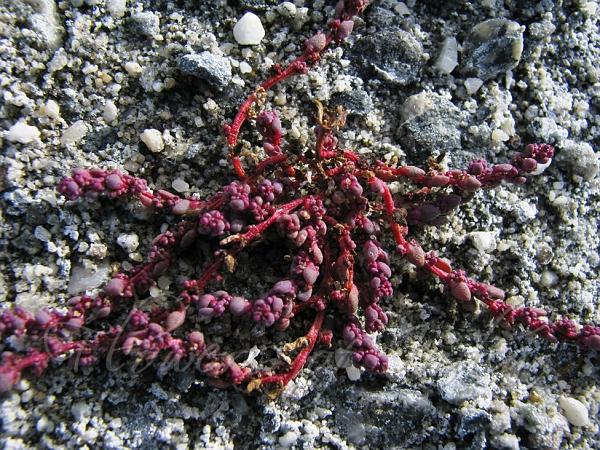|
| Siberian Seepweed |
|

|

| File size | 255107 |
| Original date | 9/14/11 4:38 PM |
| Resolution | 976 x 732 |
| Flash | Flash did not fire, auto |
| Focal length | 6.0mm |
| Exposure time | 1/640s |
| Aperture | 3.2 |
| Focus Distance | |
| Metering Mode | Center weighted average |
| Camera make | Canon |
| Camera model | Canon PowerShot S5 IS |
| Sensor type | OneChipColorArea |
|
|
|
|
Photo: |
Botanical name: Suaeda olufsenii Family: Amaranthaceae (Amaranth family)
Synonyms: Suaeda corniculata var. olufsenii
Synonyms: Suaeda corniculata var. olufsenii
Siberian's Seepweed is an annual herb, spreading
into a 5-10 x 1-10 cm expanse. It is very variable in habit, prostrate
or rising, rarely erect, primary stem usually equalled by some longer
basal laterals. Living plants are glaucous green, often purplish. Stem
is much and repeatedly branched from base, only in dwarfed specimens
unbranched, at base up to 2 mm thick; when young, with alternating
green and pale or purplish lines, later turning straw-colored. Leaves
are few, often very succulent, semi-terete, linear to oblong, 5-10 x
0.8-1.2 mm. Bracts upwards gradually shorter and changing in shape to
narrow ovate, higher up to broadly ovate and even almost circular,
shortly mucronate, usually longer than glomerules, except for the
uppermost. Bracteoles 0.5-0.7 mm long, narrow ovate or obovate, acute
or acuminate, the margins in upper part eroso-dentate. Glomerules are
3-11flowered, axillary, in case of luxuriant growth clusters with up to
30 flowers and the flowers arranged along short bracteate or ebracteate
branches that arise in pairs beside the primary axillary flower; with
flat base and strongly eccentric hilum, the tepal lobes highly
succulent, incurved, much higher than the centre of the flower, fused
for 1/2-3/4, with 1 tepal much longer and wider and 1-2 somewhat larger
than the others. Siberian's Seepweed is found in Central Asia to
SW Siberia and Western Himalaya,
in salt-marshes around permanent or temporary
lakes and in depressions with saline soils in the alpine semi-desert
zone at altitudes of 3500-4800 m. Flowering: July-September.
| Identification credit: Miroslav Dvorsky | Photographed near Pangong Lake, Ladakh. |
• Is this flower misidentified? If yes,